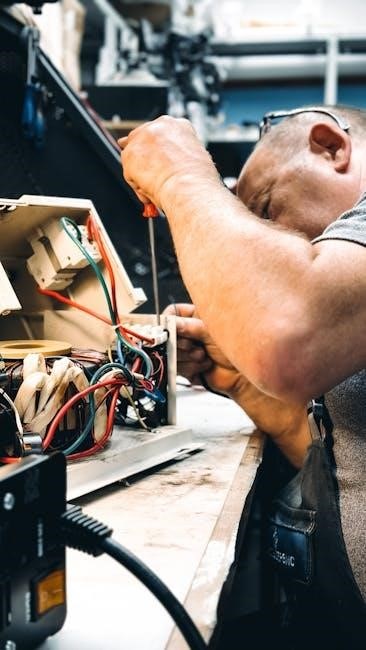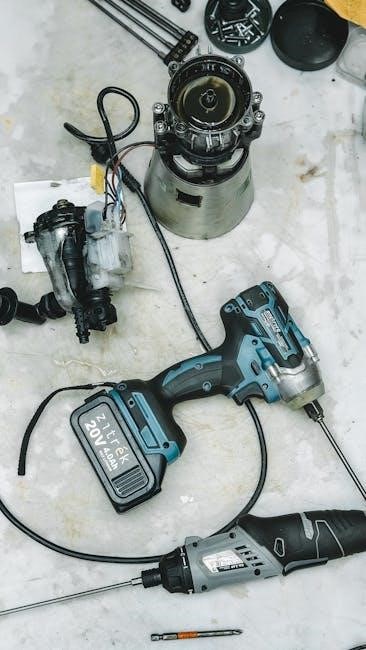The Isuzu D-Max is a durable and reliable pickup truck, known for its robust performance and versatility. Regular maintenance is essential to ensure its longevity, safety, and optimal functionality. This guide provides a comprehensive overview of the Isuzu D-Max maintenance schedule, helping owners understand the necessary checks, replacements, and services required at various mileage intervals. By following the recommended maintenance schedule, owners can prevent potential issues and maintain their vehicle’s peak performance. The Isuzu D-Max maintenance schedule is designed to address specific needs at different stages, ensuring reliability and efficiency. Always refer to the official Isuzu D-Max maintenance schedule PDF for detailed instructions and guidelines.
1.1 Overview of the Isuzu D-Max
The Isuzu D-Max is a versatile and reliable pickup truck, renowned for its durability and robust performance. Designed to handle both demanding work environments and leisure activities, it offers exceptional towing capacity and off-road capabilities. Its reputation for strength and reliability makes it a popular choice for various needs. Regular maintenance is crucial to sustain its performance and ensure longevity, which is why understanding the Isuzu D-Max maintenance schedule is essential for every owner.
1.2 Importance of Regular Maintenance
Regular maintenance is crucial for ensuring the Isuzu D-Max operates efficiently and safely. It prevents mechanical failures, reduces repair costs, and extends the vehicle’s lifespan. Proper upkeep also enhances fuel efficiency, performance, and reliability. Adhering to the Isuzu D-Max maintenance schedule helps identify potential issues early, avoiding costly breakdowns. Regular servicing ensures safety on the road and maintains the vehicle’s value over time. Consistency in maintenance is key to optimizing its durability and overall functionality, making it essential for both daily use and demanding conditions.
Understanding the Isuzu D-Max Maintenance Schedule
The Isuzu D-Max maintenance schedule is a structured plan outlining essential services and inspections at specific intervals. It ensures optimal performance, prevents issues, and extends vehicle life. Regular checks, replacements, and adjustments are detailed to maintain reliability and efficiency. By following this schedule, owners can avoid unexpected repairs and keep their D-Max in peak condition. Proper adherence ensures safety, durability, and consistent performance over time.
2.1 Key Components of the Maintenance Schedule
The Isuzu D-Max maintenance schedule includes essential inspections and services such as oil changes, filter replacements, and tire checks. Regular fluid inspections, including engine oil, coolant, and brake fluid, are critical. Brake pad and rotor inspections ensure safety, while tire pressure and tread depth checks optimize performance. Additionally, battery health and electrical system checks are vital for reliability. Adhering to these components ensures the vehicle runs smoothly and maintains its durability over time. Proper maintenance also enhances fuel efficiency and overall performance.
2.2 Recommended Maintenance Intervals
Regular maintenance for the Isuzu D-Max is recommended at specific intervals to ensure optimal performance. Oil changes are typically required every 5,000 to 10,000 km, while tire rotations should occur every 5,000 to 8,000 km. Brake pad inspections are suggested every 10,000 to 15,000 km, and fluid checks should be done every 15,000 km. Spark plug replacements are needed every 30,000 to 40,000 km, and air filter changes are recommended every 15,000 to 30,000 km. Adhering to these intervals ensures the vehicle remains in excellent condition and prevents premature wear.
2.3 Importance of Adhering to the Schedule
Adhering to the Isuzu D-Max maintenance schedule is crucial for ensuring the vehicle’s longevity, performance, and safety. Regular maintenance prevents potential issues, such as engine damage from outdated oil or brake failure from worn pads. It also maintains fuel efficiency, reduces repair costs, and ensures warranty validity. Proper upkeep enhances resale value and safety, making it essential to follow the recommended intervals for a reliable and durable driving experience.
Maintenance Requirements at Different Milestones
Maintenance needs vary based on mileage and usage. Regular checks at specific intervals ensure optimal performance, prevent issues, and extend the vehicle’s lifespan.
3.1 Maintenance at 5,000 to 10,000 km
Regular maintenance at 5,000 to 10,000 km ensures optimal performance. Essential checks include oil and filter replacement, tire pressure adjustment, and brake inspection. Fluid levels, such as coolant and brake fluid, should be verified. Additionally, inspect the air filter and belts for wear. Addressing these items early prevents potential issues and ensures reliability. Refer to the Isuzu D-Max maintenance schedule PDF for detailed guidelines tailored to this mileage range.
3.2 Maintenance at 20,000 to 40,000 km
At 20,000 to 40,000 km, maintenance focuses on ensuring long-term reliability. Key tasks include replacing the engine oil and filter, inspecting the timing belt, and checking coolant hoses for wear. Brake pads and rotors should be examined, and transmission and differential fluids may need replacement. Additionally, the air filter and spark plugs should be checked and replaced if necessary. Regular tire rotation and alignment checks are also recommended to maintain even wear and handling. Adhering to these steps ensures optimal performance and prevents costly repairs.
3.3 Maintenance at 60,000 to 100,000 km
At 60,000 to 100,000 km, maintenance becomes more detailed to address wear and tear. Replace the timing belt to prevent engine damage, and inspect coolant hoses for cracks. Brake rotors may need resurfacing or replacement, and the transmission and differential fluids should be changed. Spark plugs and air filters are typically replaced at this stage. Additionally, the exhaust system, suspension, and steering components should be inspected for any signs of wear. Following the Isuzu D-Max maintenance schedule ensures long-term reliability and performance.
3.4 Maintenance Beyond 100,000 km
Beyond 100,000 km, maintenance focuses on preventing major repairs and ensuring longevity. Replace the timing belt if not done earlier, and inspect the coolant system for leaks or corrosion. The engine’s valve clearance may need adjustment, and the water pump should be checked for wear. Suspension and steering components should be inspected for alignment and bushing condition. Additionally, the exhaust system, catalytic converter, and oxygen sensors may require attention. Regular fluid changes and battery health checks are also crucial at this stage to maintain performance and reliability over time.
Fluid and Filter Checks
Regular fluid checks ensure optimal performance. Inspect engine oil, coolant, brake, transmission, and differential fluids. Replace air and fuel filters as recommended to maintain efficiency and prevent damage.
4.1 Engine Oil and Filter Replacement
Regular engine oil and filter replacement is critical for maintaining the Isuzu D-Max’s performance and longevity. The engine oil lubricates and cools the engine, while the filter removes contaminants. Replace the oil every 5,000 to 10,000 km, depending on driving conditions. Use the viscosity grade recommended by Isuzu to ensure optimal performance. Always install a new oil filter to prevent dirt and debris from circulating through the engine. Refer to the Isuzu D-Max maintenance schedule PDF for specific guidelines and recommendations.
4.2 Coolant and Brake Fluid Checks
Regular coolant and brake fluid checks are vital for ensuring the Isuzu D-Max’s engine and braking system operate efficiently. Coolant prevents overheating and corrosion, while brake fluid ensures proper braking performance. Check coolant levels and condition every 10,000 to 15,000 km, and brake fluid every 20,000 km. Look for signs of contamination or low levels, and replace fluids as recommended in the Isuzu D-Max maintenance schedule PDF to maintain safety and performance.
4.3 Transmission and Differential Fluids
Transmission and differential fluids are essential for smooth gear operation and drivetrain lubrication. Check transmission fluid levels every 15,000 km and differential fluids every 30,000 km. Replace transmission fluid every 60,000 km and differential fluids every 80,000 km, or as specified in the Isuzu D-Max maintenance schedule PDF. Look for signs of fluid degradation, such as discoloration or viscosity changes. Regular fluid maintenance ensures proper gear shifting, reduces wear, and maintains traction in 4WD modes, prolonging the vehicle’s performance and reliability.

Tire and Brake Maintenance
Regular tire and brake checks are crucial for safety and performance. Maintain proper tire pressure, inspect tread depth, and replace worn brake pads and rotors as needed.
5.1 Tire Pressure and Tread Depth
Proper tire pressure ensures optimal performance, safety, and fuel efficiency. Check pressure monthly and before long trips, using the levels specified in the owner’s manual. Tread depth should be inspected regularly; if it falls below 1.6mm, replace the tires. Uneven wear indicates alignment issues. Regular checks help prevent blowouts and maintain traction, especially in harsh conditions. Always use a reliable pressure gauge for accurate readings and ensure tires are cold during checks for accuracy.
5.2 Brake Pad and Rotor Inspection
Regular inspection of brake pads and rotors is crucial for safety and performance. Brake pads should be checked every 10,000 to 15,000 miles or when unusual noises occur. Look for wear levels; pads worn below 3mm require replacement. Rotors should be inspected for excessive wear or warping; Ensure brake fluid levels are adequate and free from contamination. Addressing issues promptly prevents costly repairs and maintains reliable braking performance. Always refer to the Isuzu D-Max maintenance schedule PDF for precise guidelines.
5.3 Wheel Alignment and Balancing
Regular wheel alignment and balancing are crucial for maintaining tire health and vehicle stability. Misaligned wheels can cause uneven tire wear, reducing traction and fuel efficiency. Balancing ensures smooth driving by eliminating vibrations. The Isuzu D-Max maintenance schedule recommends checking alignment and balance every 15,000 to 30,000 km or when symptoms like uneven wear or vibrations occur. Proper alignment and balancing enhance safety, comfort, and overall vehicle performance. Always refer to the Isuzu D-Max maintenance schedule PDF for specific guidelines.

Battery and Electrical System Care
Regular inspections of the battery terminals and electrical connections are vital to ensure reliable starting and consistent power delivery. Clean terminals and a functioning charging system prevent electrical failures.
6.1 Battery Health and Charging System
Regularly inspect the battery terminals for corrosion and ensure they are tightly connected. Check the battery voltage and charging system performance during servicing. The alternator should be tested to confirm it is charging the battery correctly. Replace the battery if it shows signs of aging or weak performance. Follow the Isuzu D-Max maintenance schedule PDF for recommended intervals to ensure the electrical system remains reliable and prevents unexpected breakdowns.
6.2 Alternator and Starter Motor Check
Inspect the alternator belt for signs of wear or cracks and ensure proper tension. Test the alternator’s charging capacity to confirm it meets specifications. Check the starter motor for smooth operation and proper electrical connections. Replace any worn or faulty components to prevent breakdowns. Refer to the Isuzu D-Max maintenance schedule PDF for recommended intervals and procedures to ensure the electrical system functions reliably and efficiently at all times.

Common Issues and Troubleshooting
Common issues with the Isuzu D-Max include engine oil leaks, faulty alternators, and worn brake pads. Regular checks and timely replacements can prevent major breakdowns. Owners should monitor warning signs like unusual noises or dashboard alerts. Consulting the Isuzu D-Max maintenance schedule PDF ensures proper troubleshooting and maintenance, keeping the vehicle in optimal condition for years.
7.1 Identifying Warning Signs
Identifying warning signs early is crucial for preventing major repairs. Common indicators include illuminated dashboard lights, unusual noises, or decreased performance. The check engine light may signal issues like faulty sensors or misfires. Low oil pressure alerts or coolant temperature warnings require immediate attention. Strange noises, such as grinding or knocking sounds, often indicate worn brakes or engine problems. Regular inspections, as outlined in the Isuzu D-Max maintenance schedule PDF, help catch these issues before they escalate, ensuring safety and reliability on the road.
7.2 Addressing Common Maintenance Issues
Common maintenance issues with the Isuzu D-Max include oil leaks, worn brake pads, and faulty sensors. Addressing these promptly prevents further damage. For oil leaks, inspect gaskets and seals. Brake pads should be replaced if thickness falls below 3mm. Faulty sensors may require resetting or replacement. Always consult the Isuzu D-Max maintenance schedule PDF for guidance. Regular inspections and timely repairs ensure reliability and safety. Professional assistance is recommended for complex issues to avoid complications.
DIY Maintenance Guide
A DIY maintenance guide for the Isuzu D-Max empowers owners to perform basic checks and repairs. Essential tools include wrenches, screwdrivers, and oil filters. Regular tasks like oil changes, tire pressure checks, and filter replacements can be done at home, saving time and money. Always refer to the Isuzu D-Max maintenance schedule PDF for specific instructions and safety precautions to ensure proper execution.
8.1 Tools and Equipment Needed
Essential tools for DIY Isuzu D-Max maintenance include a set of wrenches, screwdrivers, pliers, and a socket set, crucial for various repairs and adjustments. Specialized tools like an oil drain pan, tire pressure gauge, and Allen keys are necessary for tasks such as oil changes and tire rotations. Safety gear such as gloves, goggles, and sturdy boots should always be worn to protect yourself while working on the vehicle. Refer to the Isuzu D-Max maintenance schedule PDF for a precise list of tools needed for each task to ensure accuracy and safety.
8.2 Step-by-Step DIY Maintenance Tips
Start with an oil change by draining the old oil and replacing the filter. Check coolant and brake fluid levels, topping up as needed. Inspect tire pressure and tread depth, adjusting or replacing tires as necessary. Replace the air filter every 15,000 km for improved engine performance. Check brake pads and rotors for wear, ensuring they are within safe limits. Always consult the Isuzu D-Max maintenance schedule PDF for specific instructions tailored to your vehicle’s needs.

Cost of Maintenance
Regular maintenance costs for the Isuzu D-Max vary between $300 to $700 every 10,000 to 15,000 km, depending on mileage and location. Major services or repairs can range from $1,000 to $2,500. Factors like labor rates and parts availability influence costs. Always consult the Isuzu D-Max maintenance schedule PDF for detailed pricing and recommendations.
9.1 Estimated Costs for Regular Servicing
Regular servicing for the Isuzu D-Max typically ranges between $300 and $700 every 10,000 to 15,000 km. Minor services, such as oil changes and filter replacements, cost around $200-$400. Major services, including timing belt replacements and comprehensive checks, can range from $800 to $1,500. Costs vary depending on location, labor rates, and dealership pricing. Always refer to the Isuzu D-Max maintenance schedule PDF for detailed estimates and recommendations tailored to your vehicle’s needs.
9.2 Factors Affecting Maintenance Costs
Maintenance costs for the Isuzu D-Max vary based on labor rates, genuine part prices, and the vehicle’s mileage. Dealership services often cost more than independent mechanics. The age and condition of the vehicle, as well as any custom modifications, also influence expenses. High-mileage vehicles may require more frequent repairs, increasing costs. Additionally, location and availability of parts can impact pricing. Refer to the Isuzu D-Max maintenance schedule PDF for tailored advice on minimizing expenses while maintaining performance.

Warranty and Service Plans
The Isuzu D-Max comes with a manufacturer’s warranty, providing coverage for parts and labor under specified conditions. Extended service plans are also available, offering additional protection and peace of mind; These plans can reduce long-term maintenance costs and ensure continued reliability. Always review the terms and conditions to understand coverage details and exclusions.
10.1 Understanding the Manufacturer’s Warranty
The Isuzu D-Max manufacturer’s warranty provides coverage for defects in materials and workmanship, ensuring repairs or replacements are free under specified conditions. Typically, the warranty covers the vehicle for a certain period or mileage, such as three years or 100,000 km. This coverage includes essential components like the engine, transmission, and electrical systems. The warranty terms vary by region, so it’s crucial to review the official documentation or consult with an authorized Isuzu dealer for precise details. Proper maintenance as per the schedule can help maintain warranty validity and prevent coverage issues. Always keep service records handy for warranty claims and ensure all recommended services are completed on time to uphold coverage. This approach ensures the vehicle remains protected and performs optimally throughout the warranty period.
10.2 Extended Service Plans and Benefits
Extended service plans offer additional protection beyond the manufacturer’s warranty, providing coverage for repairs and maintenance after the standard warranty expires. These plans can be tailored to specific vehicle needs and usage patterns, offering benefits like extended mileage or time coverage. They help protect against unexpected repair costs and ensure continued access to authorized service centers. Extended plans can also enhance resale value and provide peace of mind for long-term ownership. Always review terms and conditions to understand what is covered and for how long.
Digital Tools for Maintenance Scheduling
Digital tools like the Isuzu D-Max maintenance PDF guide and mobile apps offer convenient ways to track and schedule maintenance, ensuring your vehicle stays in top condition.
11.1 Using the Isuzu D-Max Maintenance PDF Guide
The Isuzu D-Max maintenance PDF guide provides a detailed and structured approach to vehicle upkeep. It outlines specific service intervals, required inspections, and replacement schedules, ensuring clarity and ease of use. Owners can access this guide online, making it a convenient resource for staying informed about their vehicle’s needs. Regularly referencing the PDF helps maintain the truck’s performance and extends its lifespan. By following the guide, owners can address potential issues early, reducing the risk of costly repairs and ensuring reliability on and off the road.
11.2 Mobile Apps for Tracking Maintenance
Mobile apps offer a convenient way to track and manage Isuzu D-Max maintenance schedules. These apps provide reminders for upcoming services, allow users to log completed maintenance, and offer real-time updates. They often include features like oil change tracking, mileage logging, and access to service history. By utilizing these tools, owners can stay organized and ensure their vehicle receives the necessary care on time. Mobile apps enhance convenience and help maintain the truck’s optimal performance and longevity.
Best Practices for Vehicle Longevity
Regular maintenance, proper storage, and careful driving habits are key to extending the Isuzu D-Max’s lifespan. Avoiding extreme temperatures, minimizing load stress, and keeping the vehicle clean also contribute to its longevity.
12.1 Driving Habits to Extend Vehicle Life
Avoid aggressive driving, such as rapid acceleration or hard braking, as it stresses the engine and brakes. Maintain consistent speeds, especially on highways, to reduce wear on the transmission and engine. Avoid overloading the vehicle, as it can strain the suspension and chassis. Regularly check tire pressure and avoid driving in extreme temperatures for extended periods. Proper towing techniques and avoiding sudden shifts between 4WD modes also help preserve the Isuzu D-Max’s longevity.
12.2 Storage and Cleaning Tips
Regular cleaning is crucial for maintaining the Isuzu D-Max’s appearance and longevity. Wash the vehicle regularly to remove dirt and grime, paying attention to the undercarriage to prevent rust. Avoid using harsh chemicals that may damage the paint or surfaces. Store the vehicle in a shaded, dry area or use a breathable cover to protect from sunlight and moisture. For long-term storage, disconnect the battery and ensure the fuel tank is full to prevent rust and corrosion.
Regular maintenance is crucial for the Isuzu D-Max’s reliability and durability. Adhere to the schedule, perform checks, and follow best practices to ensure optimal performance and longevity. Always consult the official Isuzu D-Max maintenance schedule PDF for detailed guidance, ensuring your vehicle remains in peak condition for years to come.
13.1 Summary of Key Maintenance Points
Regular maintenance is vital for the Isuzu D-Max’s performance and longevity. Key points include adhering to the recommended schedule, checking engine oil, coolant, and brake fluids, inspecting tires, and ensuring proper battery function. Addressing wear on brakes and suspension is crucial, while following DIY tips can enhance vehicle care. Consulting the Isuzu D-Max maintenance schedule PDF ensures adherence to specific guidelines, optimizing reliability and efficiency over time. Consistent upkeep prevents costly repairs and extends the vehicle’s lifespan significantly.
13.2 Final Tips for Isuzu D-Max Owners
Always follow the Isuzu D-Max maintenance schedule PDF for guidance. Keep a maintenance log to track services and inspections. Avoid aggressive driving habits to reduce wear on components. Regularly inspect tires, brakes, and fluids to ensure safety. Address any issues promptly to prevent costly repairs. Consider consulting a professional for complex tasks. Stay updated with the latest maintenance guidelines for optimal performance. Proper care ensures the longevity and reliability of your Isuzu D-Max, making it a trusted companion for years to come.

